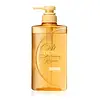What's inside
What's inside
 Key Ingredients
Key Ingredients

 Benefits
Benefits

 Concerns
Concerns

 Ingredients Side-by-side
Ingredients Side-by-side

Water
Skin ConditioningTea-Lauroyl Sarcosinate
CleansingPalm Kernelamidopropyl Betaine
CleansingCocamide Methyl Mea
Glycol Distearate
EmollientCocamide Mea
EmulsifyingTea-Cocoyl Glutamate
CleansingParfum
MaskingSodium Chloride
MaskingPEG-7 Glyceryl Cocoate
EmulsifyingCitric Acid
BufferingSodium Benzoate
MaskingPolyquaternium-10
Guar Hydroxypropyltrimonium Chloride
Skin ConditioningDisodium EDTA
Polyquaternium-7
Oryza Sativa Germ Oil
EmollientButylene Glycol
HumectantOryza Sativa Bran Oil
EmollientAlcohol
AntimicrobialCaramel
Cosmetic ColorantPropanediol
SolventCamellia Japonica Seed Extract
Skin ConditioningBelamcanda Chinensis Root Extract
Skin ConditioningOryza Sativa Bran Extract
Skin ConditioningPhenoxyethanol
PreservativeSapindus Mukorossi Peel Extract
Skin ConditioningDianthus Longicalyx Seed Extract
Emulsion StabilisingOryza Sativa Extract
AbsorbentWater, Tea-Lauroyl Sarcosinate, Palm Kernelamidopropyl Betaine, Cocamide Methyl Mea, Glycol Distearate, Cocamide Mea, Tea-Cocoyl Glutamate, Parfum, Sodium Chloride, PEG-7 Glyceryl Cocoate, Citric Acid, Sodium Benzoate, Polyquaternium-10, Guar Hydroxypropyltrimonium Chloride, Disodium EDTA, Polyquaternium-7, Oryza Sativa Germ Oil, Butylene Glycol, Oryza Sativa Bran Oil, Alcohol, Caramel, Propanediol, Camellia Japonica Seed Extract, Belamcanda Chinensis Root Extract, Oryza Sativa Bran Extract, Phenoxyethanol, Sapindus Mukorossi Peel Extract, Dianthus Longicalyx Seed Extract, Oryza Sativa Extract
Water
Skin ConditioningIsopentyldiol
HumectantStearyl Alcohol
EmollientBehentrimonium Chloride
PreservativeGlycerin
HumectantDimethicone
EmollientCetearyl Alcohol
EmollientBehenyl Alcohol
EmollientAminopropyl Dimethicone
Hydrogenated Polyisobutene
EmollientSteartrimonium Chloride
PreservativePolysilicone-13
Camellia Seed Oil
Lactic Acid
BufferingLysine Lauroyl Glutamate
CleansingSqualane
EmollientRoyal Jelly Extract
Skin ConditioningGlycine Max Seed Extract
Skin ConditioningIsopropyl Alcohol
SolventDipropylene Glycol
HumectantIsopropyl Myristate
EmollientPEG-2 Laurate
EmulsifyingSalicylic Acid
MaskingAmodimethicone
PPG-2-Deceth-12
EmulsifyingMethylserine
Skin ConditioningDisodium EDTA
Cetrimonium Chloride
AntimicrobialButylene Glycol
HumectantTocopherol
AntioxidantSodium Benzoate
MaskingPhenoxyethanol
PreservativeParfum
MaskingCI 17200
Cosmetic ColorantCI 15985
Cosmetic ColorantWater, Isopentyldiol, Stearyl Alcohol, Behentrimonium Chloride, Glycerin, Dimethicone, Cetearyl Alcohol, Behenyl Alcohol, Aminopropyl Dimethicone, Hydrogenated Polyisobutene, Steartrimonium Chloride, Polysilicone-13, Camellia Seed Oil, Lactic Acid, Lysine Lauroyl Glutamate, Squalane, Royal Jelly Extract, Glycine Max Seed Extract, Isopropyl Alcohol, Dipropylene Glycol, Isopropyl Myristate, PEG-2 Laurate, Salicylic Acid, Amodimethicone, PPG-2-Deceth-12, Methylserine, Disodium EDTA, Cetrimonium Chloride, Butylene Glycol, Tocopherol, Sodium Benzoate, Phenoxyethanol, Parfum, CI 17200, CI 15985
 Reviews
Reviews

Ingredients Explained
These ingredients are found in both products.
Ingredients higher up in an ingredient list are typically present in a larger amount.
Butylene Glycol (or BG) is used within cosmetic products for a few different reasons:
Overall, Butylene Glycol is a safe and well-rounded ingredient that works well with other ingredients.
Though this ingredient works well with most skin types, some people with sensitive skin may experience a reaction such as allergic rashes, closed comedones, or itchiness.
Learn more about Butylene GlycolDisodium EDTA plays a role in making products more stable by aiding other preservatives.
It is a chelating agent, meaning it neutralizes metal ions that may be found in a product.
Disodium EDTA is a salt of edetic acid and is found to be safe in cosmetic ingredients.
Learn more about Disodium EDTAParfum is a catch-all term for an ingredient or more that is used to give a scent to products.
Also called "fragrance", this ingredient can be a blend of hundreds of chemicals or plant oils. This means every product with "fragrance" or "parfum" in the ingredients list is a different mixture.
For instance, Habanolide is a proprietary trade name for a specific aroma chemical. When used as a fragrance ingredient in cosmetics, most aroma chemicals fall under the broad labeling category of “FRAGRANCE” or “PARFUM” according to EU and US regulations.
The term 'parfum' or 'fragrance' is not regulated in many countries. In many cases, it is up to the brand to define this term.
For instance, many brands choose to label themselves as "fragrance-free" because they are not using synthetic fragrances. However, their products may still contain ingredients such as essential oils that are considered a fragrance by INCI standards.
One example is Calendula flower extract. Calendula is an essential oil that still imparts a scent or 'fragrance'.
Depending on the blend, the ingredients in the mixture can cause allergies and sensitivities on the skin. Some ingredients that are known EU allergens include linalool and citronellol.
Parfum can also be used to mask or cover an unpleasant scent.
The bottom line is: not all fragrances/parfum/ingredients are created equally. If you are worried about fragrances, we recommend taking a closer look at an ingredient. And of course, we always recommend speaking with a professional.
Learn more about ParfumPhenoxyethanol is a preservative that has germicide, antimicrobial, and aromatic properties. Studies show that phenoxyethanol can prevent microbial growth. By itself, it has a scent that is similar to that of a rose.
It's often used in formulations along with Caprylyl Glycol to preserve the shelf life of products.
Sodium Benzoate is a preservative. It's used in both cosmetic and food products to inhibit the growth of mold and bacteria. It is typically produced synthetically.
Both the US FDA and EU Health Committee have approved the use of sodium benzoate. In the US, levels of 0.1% (of the total product) are allowed.
Sodium benzoate works as a preservative by inhibiting the growth of bacteria inside of cells. It prevents the cell from fermenting a type of sugar using an enzyme called phosphofructokinase.
It is the salt of benzoic acid. Foods containing sodium benzoate include soda, salad dressings, condiments, fruit juices, wines, and snack foods.
Studies for using ascorbic acid and sodium benzoate in cosmetics are lacking, especially in skincare routines with multiple steps.
We always recommend speaking with a professional, such as a dermatologist, if you have any concerns.
Learn more about Sodium BenzoateWater. It's the most common cosmetic ingredient of all. You'll usually see it at the top of ingredient lists, meaning that it makes up the largest part of the product.
So why is it so popular? Water most often acts as a solvent - this means that it helps dissolve other ingredients into the formulation.
You'll also recognize water as that liquid we all need to stay alive. If you see this, drink a glass of water. Stay hydrated!
Learn more about Water